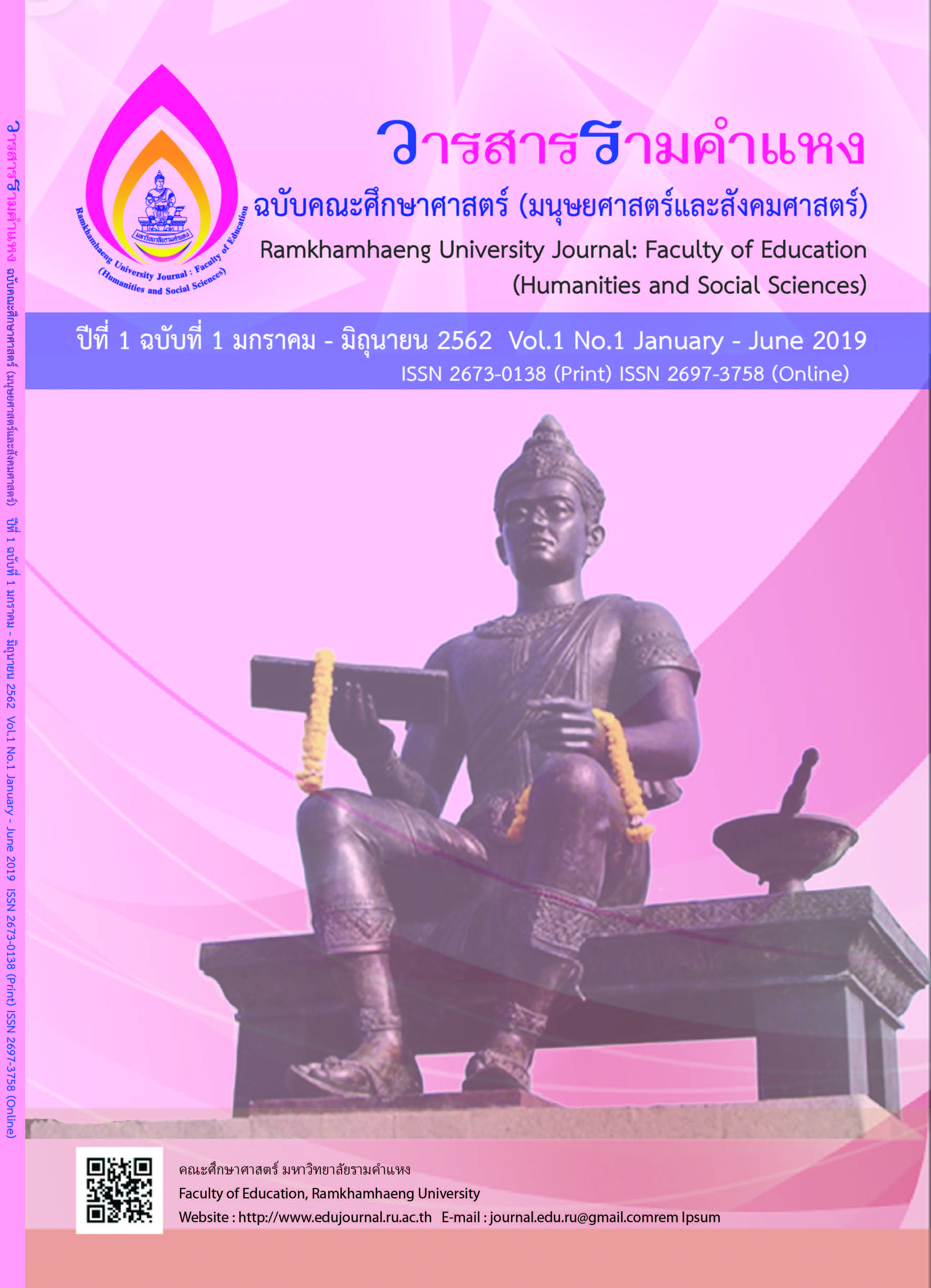ความสัมพันธ์และการทำนายคุณลักษณะของผู้ใช้อินเทอร์เน็ตที่มีต่อการติดอินเทอร์เน็ต ของนักศึกษามหาวิทยาลัยระดับปริญญาตรี
Main Article Content
บทคัดย่อ
การศึกษาครั้งนี้ มีวัตถุประสงค์เพื่อหาความสัมพันธ์และทํานายคุณลักษณะของผู้ใช้อินเทอร์เน็ต ได้แก่ อายุ ที่เริ่มใช้งานอินเทอร์เน็ต ความยาวนานของการใช้งานอินเทอร์เน็ตตั้งแต่เริ่มจนถึงปัจจุบัน และระยะเวลาที่ใช้อินเทอร์เน็ต เฉลี่ยต่อวันที่มีต่อการติดอินเทอร์เน็ตของนักศึกษามหาวิทยาลัยระดับปริญญาตรี จํานวน 258 คน (เป็นเพศหญิง ร้อยละ 80.6 และเพศชาย ร้อยละ 19.4) มีอายุระหว่าง 18-25 ปี และเป็นผู้ที่สามารถเข้าถึงอินเทอร์เน็ตได้เก็บข้อมูลด้วย แบบสอบถามข้อมูลทั่วไป และแบบสอบถาม Internet Addiction Test (IAT) ผลจากการศึกษา พบว่า อายุที่เริ่มใช้งาน อินเทอร์เน็ตและระยะเวลาที่ใช้อินเทอร์เน็ตเฉลี่ยต่อวันมีความสัมพันธ์กับการติดอินเทอร์เน็ตอย่างมีนัยสําคัญทางสถิติ (rxy =-.131, p-value < .05 และ rxy = .283, p-value < .01 ตามลําดับ) โดยระยะเวลาที่ใช้อินเทอร์เน็ตเฉลี่ยต่อวัน สามารถทํานายการติดอินเทอร์เน็ตได้อย่างมีนัยสําคัญทางสถิติที่ระดับ .01 (฿ = 296, p-value < .001) ความรู้ที่ได้จาก การวิจัยครั้งนี้ จึงเป็นข้อมูลพื้นฐานเพื่อการออกแบบโปรแกรมส่งเสริมสุขภาวะที่ให้ความสําคัญกับการส่งเสริมและ < ปลูกฝังให้เกิดพฤติกรรมการใช้งานอินเทอร์เน็ตอย่างเหมาะสมตั้งแต่วัยเด็ก เพื่อพัฒนาไปเป็นบุคคลยุคดิจิทัลที่รู้เท่าทันเทคโนโลยี
Downloads
Article Details

อนุญาตภายใต้เงื่อนไข Creative Commons Attribution-NonCommercial-NoDerivatives 4.0 International License.
ผู้ส่งบทความ (และคณะผู้วิจัยทุกคน) ตระหนักและปฎิบัติตามจริยธรรมการวิจัยอย่างเคร่งครัด ทั้งนี้บทความ เนื้อหา ข้อมูล ข้อความ ภาพ ตาราง แผนภาพ แผนผัง หรือข้อคิดเห็นใดๆ ที่ปรากฎในบทความ เป็นความคิดเห็นและความรับผิดชอบของผู้ส่งบทความ กองบรรณาธิการไม่จำเป็นต้องเห็นตามเสมอไป และไม่มีส่วนรับผิดชอบใดๆ โดยถือเป็นความรับผิดของของเจ้าของบทความเพียงผู้เดียว
เอกสารอ้างอิง
American Psychiatric Association. (1994). Diagnostic and statistical manual of mental disorders (4th ed.). Washington, DC: Authors.
American Psychiatric Association. (2000). Diagnostic and statistical manual of mental disorders (4th ed. Text Rev.). Washington, DC: Authors.
American Psychiatric Association. (2013). Diagnostic and statistical manual of mental disorders (5th ed.). Arlington, VA: American Psychiatric Publishing.
Boumosleh, J. M., & Jaalouk, D. (2017). Depression, anxiety, and smartphone addiction inuniversity students-A cross sectional study. PLOS ONE, 12(8), e0182239.
Chen, B., Liu, F., Ding, S., Ying, X., Wang, L., & Wen, Y. (2017). Gender differences in factors associated with smartphone addiction: A cross-sectional study among medical college students. BMC Psychiatry, 17, 341-349.
Cho, H., Kwon, M., Choi, J. H., Lee, S. K., Choi, J. S., Choi, S. W., & Kim, D. J. (2014). Development of the Internet Addiction Scale based on the Internet Gaming Disorder criteria suggested in DSM-5. Addictive Behaviors, 39, 1361-1366.
Choi, S. W., Kim, D. J., Choi, J. S., Ahn, H., Choi, E. J., Song, W. Y., Kim, S., & Youn, H. (2015). Comparison of risk and protective factors associated with smartphone addiction and Internet addiction. Journal of Behavioral Addictions, 4(4), 308-314.
Demirci, K., Akgönül, M., & Akpinar, A. (2015). Relationship of smartphone use severity with sleep quality, depression, and anxiety in university students. Journal of Behavioral Addictions, 4(2), 85-92.
Kuss, D. J., Van Rooij, A, J., Shorter, G. W., Griffiths, M. D., & Mheen, D. V. (2013). Internet addiction in adolescents: prevalence and risk factors. Computers in Human Behavior, 29, 1987-1996.
Laconi, S., Tricard, N., & Chabrol, H. (2015). Differences between specific and generalized problematic Internet uses according to gender, age, time spent online and psychopathological symptoms. Computers in Human Behavior, 48, 236-244.
Liu, T., & Potenza, M. (2007). Problematic Internet use: Clinical implications. CNS Spectrums, 12(6), 453-466. The Statistics Portal. (2018). Number of internet users in Thailand. Retrieved May 25, 2018, fromhttps://www.statista.com/statistics/553730/number-of-internet-users-thailand/
The Survey System. (2012). Sample size calculation. Retrieved May 25, 2018, from https://www.surveysystem.com/sscalc.htm
Wanajak, K. (2011). Internet use and its impact on secondary school students in Chiang Mai, Thailand. (Ph.D. Dissertation). Edith Cowan University.
Wisessathorn, M. (2015, 30 September-2 October). Personality, academic success and quality of life of undergraduate students with perceiving internet addiction. In SEAAIR 2015 Conference Proceedings (pp. 50-61). Paper presented at Internationalization and Inclusivity of Higher Education in South East Asia: Perspectives, Practices and Pragmatics. Hanoi: Labour Publishing House.
Wissesathorn, M. (2017). The development of a Thai-Internet Dependency Scale (T-IDS) and its psychometric properties. Journal of Institutional Research in South East Asia, 3(15), 44-59.
Wong, T. Y., Yuen, K. S. L., & Li, W. O. (2015). A basic need theory approach to problematic Internet use and the mediating effect of psychological distress. Frontiers in Psychology, 5, 1562.
Xin, M., Xing, J., Pengfei, W., Houru, L., Mengcheng, W., & Hong, Z. (2018). Online activities, prevalence of Internet addiction and risk factors related to family and school among adolescents in China. Addictive Behaviors Reports, 7, 14-18.
Young, K. S. (1996). Internet addiction: The emergence of a new clinical disorder. Cyberpsychology and Behavior, 1(3), 237-244.
Young, K. S. (1998). Caught in the net: how to recognize the signs of internet addiction and a winning strategy for recovery. NY: Wiley.
Young, K. S. (2013). Treatment outcomes using CBT-IA with Internet-addicted patients. Journal of Behavioral Addictions, 2(4), 209-215.


